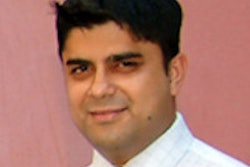SAN DIEGO - The reading of after-hours emergency room head CT scans by board-certified general radiologists demonstrates an interpretation performance within a couple of percentage points of neuroradiologists, according to a study presented at the American Roentgen Ray Society's annual meeting on Wednesday.
"In many hospitals there is the desire to provide continuous, top-quality care 24 hours a day and seven days a week," said Dr. William Erly of the University of Arizona in Tucson, where the study was conducted.
Erly led a team of researchers to assess the accuracy of general radiologists in the interpretation of emergency head CT scans via teleradiology. The group reviewed 716 consecutive ER head CT exams that were interpreted on-call by one of 15 board-certified general radiologists.
The radiologists included in the study represented 96% (1,649) of the 1,709 acute-care hospital beds covered by private-practice radiologists in the Southwestern city. The only facility not covered was a 60-bed cardiac hospital, according to Erly.
Images were sent to the on-call radiologists via a teleradiology system (Eastman Kodak Health Imaging, Rochester, NY) and a preliminary interpretation was made. Of the 15 general radiologists reviewed in the study, three functioned solely in a nighthawk capacity and 12 were on-call in addition to their normal daytime duties.
The exams were interpreted by one of five neuroradiologists the following day. The CT examinations included in the study involved a mix of patients including stroke, car accident, and other head trauma victims, said Erly.
The preliminary interpretations were categorized by Erly and his colleagues as agree, insignificant disagreement, or significant disagreement. Reports that landed in the insignificant or significant disagreement areas were then reviewed and re-classified by a consensus of three U of A-based neuroradiologists.
According to the results, the general radiologist and the final neuroradiologist interpretations were in agreement on 95% (677) of the exams, insignificant disagreement on 3% (23) of the exams, and significant disagreement on 2% (16) of the exams.
"Originally there were 44 case disagreements but on review we reclassified 5 of them as agreements," Erly said.
Erly said that of the 16 errors classified as "significant" by the neuroradiologists, five were false-positive and 11 were false-negative errors. He also noted that 47 of the cases had significant or active pathology, and in 11 of these cases (23%) the final reports were significantly different from the preliminary interpretation.
However, three of the patients had sella masses, none of which were described on the preliminary interpretation.
"In no instance was there a critically adverse outcome. But if a neuroradiologist had not looked at the scans, there could have been worse outcomes than there were," observed Erly.
Although the researchers did not record the time of night when a general radiologist read each scan, they did believe it would be of interest to see how the time of read affected the performance of the preliminary interpretations.
"I think a lot of the misses were due to the fact that the films were read in the middle of the night. I don’t know how the neuroradiologists would do if they were up all night reading, too. It’s my guess that they would miss things as well," Erly noted.
"Another question is how many head CT exams are the general radiologists reading on a daily basis? If they’re not working with these types of studies during normal working hours and are only reading them in the middle of the night as part of their call duties, chances are they’re going to miss more than a well-rested neuroradiologist the next morning," he said.
The research team has plans to examine how neuroradiologists perform under similar conditions, by having neuroradiologists overread one another. Preliminary numbers appear to be similar, with about a 1% miss rate for the neuroradiologists, compared with a 2% miss rate for the general radiologists, according to Erly.
By Jonathan S. Batchelor
AuntMinnie.com staff writer
May 8, 2003
Related Reading
Residents' after-hours CT interpretation shows high accuracy, March 4, 2003
Plain film x-rays not needed with CT to evaluate polytrauma spinal injuries, December 6, 2003
Pediatric ankle exam predicts need for x-rays, November 1, 2002
Emergency Imaging of the Acutely Ill or Injured Child, September 10, 2002
Education is the solution for on-call radiology, February 21, 2002
Copyright © 2003 AuntMinnie.com



















